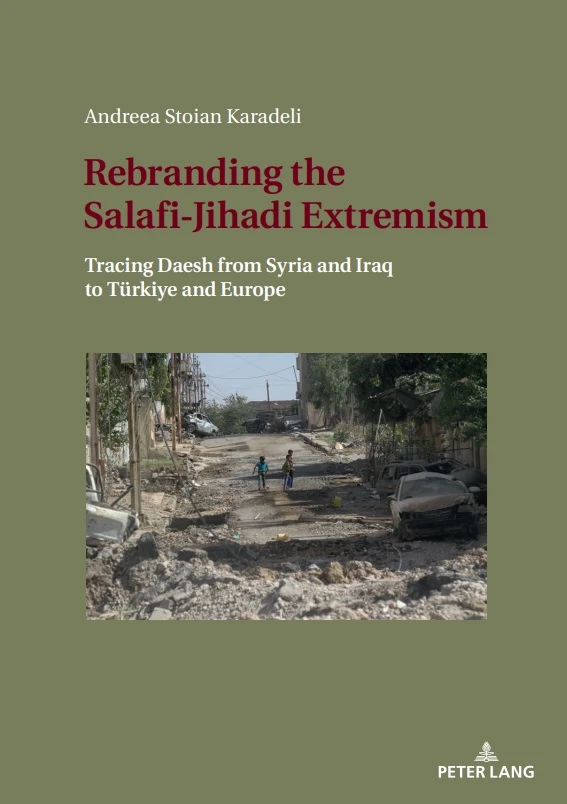Rebranding the Salafi-Jihadi Extremism
Tracing Daesh from Syria and Iraq to Türkiye and Europe
Summary
Excerpt
Table Of Contents
- Cover
- Half Title
- Title
- Copyright
- Table of Contents
- List of Figures
- List of Tables
- Introduction
- Chapter 1 The Historical Evolution of Terrorism Leading to Daesh
- Chapter 2 The Daesh Phenomenon
- Chapter 3 The Geopolitics of Terrorism: Türkiye’s Position at the Nexus of Regional Conflicts
- Chapter 4 Daesh in Türkiye: A Tale of Many Narratives
- Chapter 5 The Daesh Challenge for Türkiye and the EU: Converging Threats, Diverging Responses
- Conclusion
- Bibliography
- Annex 1. Partitioning of Anatolia by the Treaty of Sevres 1920 (Reed, 1924)
- Annex 2. Main Centres and Groups in the Daesh Network in Türkiye
- Annex 3. Various Routes Taken by Foreign Terrorist Fighters to Arrive in Syria
- Annex 4. Map of the Transit Routes Between Türkiye and Syria
- Annex 5. Two Primary Routes of Foreign Terrorist Fighters Transiting Through Türkiye on Their Way to Syria
Rebranding the Salafi-Jihadi Extremism
Tracing Daesh from Syria and Iraq to Türkiye and Europe
Table of Contents
Chapter 1
The Historical Evolution of Terrorism Leading to Daesh
Chapter 2
The Daesh Phenomenon
Chapter 3
The Geopolitics of Terrorism: Türkiye’s Position at the Nexus of Regional Conflicts
Chapter 4
Daesh in Türkiye: A Tale of Many Narratives
Chapter 5
The Daesh Challenge for Türkiye and the EU: Converging Threats, Diverging Responses
Annex 1. Partitioning of Anatolia by the Treaty of Sevres 1920 (Reed, 1924)
Annex 2. Main Centres and Groups in the Daesh Network in Türkiye
Annex 3. Various Routes Taken by Foreign Terrorist Fighters to Arrive in Syria
Annex 4. Map of the Transit Routes Between Türkiye and Syria
Figures
Figure 6: Original Number of foreign fighters in Syria by country. (ICSR, 2017)
Figure 7: The evolution of terrorism in Türkiye 1970–2017 (NCSTRT, 2018)
Figure 9: Global audience of online pages with jihadist content (Statista, 2017)
Figure 10: Daesh attacks targeting Türkiye according to the personal database
Figure 12: Count of no. of attacks by year and country for Türkiye
Figure 13: Count of no. of attacks for Türkiye by target 2014–2021
Figure 14: Attacks by target and geographical location for Türkiye
Figure 15: Geographical location of the complex attacks for Türkiye
Figure 17: Foreign Terrorist Fighters in Syria and Iraq 2014–2015 (Soufan Group, 2015)
Figure 18: Foreign terrorist fighters by region of origin (Soufan Group, 2017)
Figure 19: Profile elements of foreign terrorist fighters from the European Union (ICCT, 2016)
Figure 21: Sum of attack by type of attack in European Union and Türkiye
Figure 22: Sum of attack by type of attack in European Union and Türkiye
Figure 23: The article from the ‘Just terror tactics’ column, published in Rumiyah
Tables
Introduction
‘O ka’u olelo ko’u mana’ / ‘My words are my power’
The history of terrorism is common to the history of humanity, dating from the time of the first communities of people. Terrorism seems to perfectly embody the legend of the Phoenix bird resurrecting from its ashes, each time stronger, more challenging, and more difficult to fight. Paradoxically, just like the Phoenix bird, terrorist groups are not entirely defeated, and they always find the opportunity to come back in a new form.
One of the latest and most feared forms of the terrorist phenomenon, الدولة الإسلامية في العراق والشام / ‘al-Dawla al-Islamiyya fi al-Iraq and al-Sham’ / Daesh / Islamic State of Iraq and Sham / ISIS / Islamic State of Iraq and Levant / ISIL / the Islamic States / IS has evolved as a terrorist organisation adapted to the opportunities of modern society. Daesh has set a precedent for all religious-inspired terrorist organisations in general, and Salafi-jihadists in particular by self-proclaiming the Islamic Caliphate on 29 June 2014.
Daesh is an embodiment of jihadism that was reinvented in a form adapted to the contemporary society, fully aware of the potential offered by the development of technology and means of communication and using them to its advantage. The evolution of this terrorist organisation together with its short, medium, but especially long-term consequences represent a subject that needs to be analysed contextually and understood in the smallest detail to develop an effective strategy against it. So far, the international community has tended to consider itself all-knowing against the adversary in the fight against terrorism, and this has had devastating consequences. Standing as a perfect example, the present case of Daesh is a direct result of an unfortunate set of decisions taken using a superficial knowledge of the phenomenon together with a late response against the organisation in its previous forms, both elements favouring its evolution.
At present, the organisation is territorially defeated, but, withdrawn in insurgency and branched at global level, it continues to represent a threat to international security in different forms: through its presence in conflict zones or in regions with deteriorating security and stability, through affiliated terrorist organisations, through declared members and hidden supporters, through the reorganisation into clandestine forms that make it difficult to track, through the ‘virtual Islamic Caliphate’ that has been active in the online environment, and through the discourse that continues to attract and radicalise.
As such, the fight against Daesh has not come to an end, the organisation perfectly reflecting a complex phenomenon that must be understood in depth, with all its global ramifications, in physical and online environment.
Details
- Pages
- 316
- Publication Year
- 2025
- ISBN (PDF)
- 9783631940860
- ISBN (ePUB)
- 9783631940877
- ISBN (Hardcover)
- 9783631865736
- DOI
- 10.3726/b23062
- Language
- English
- Publication date
- 2025 (August)
- Keywords
- Daesh Turkiye EU Syria Iraq Terrorism Counterterrorism Salafi-Jihadi
- Published
- Berlin, Bruxelles, Chennai, Lausanne, New York, Oxford, 2025. 316 pp., 28 fig. b/w, 5 tables.
- Product Safety
- Peter Lang Group AG

